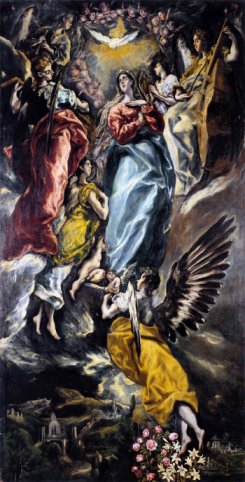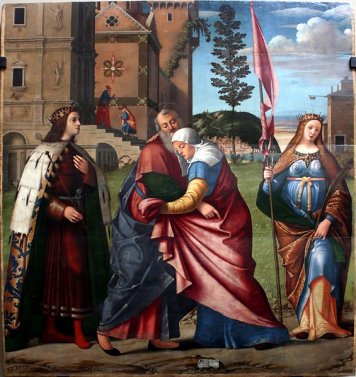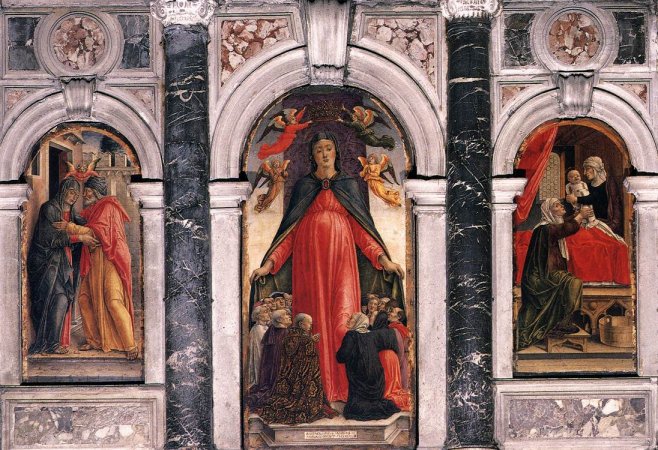|
|
|
|
|
|
|
This is one of the more controversial of Catholic Doctrines, and for non-Catholics can be one of the most misunderstood. In 1854, Pope Pius IX defined it thus: that the Blessed Virgin Mary 'in the first instance of her conception, by a singular privilege and grace granted by God, in view of the merits of Jesus Christ, the Saviour of the human race, was preserved exempt from all stain of original sin.' To clarify. The doctrine in no way suggests that Mary was conceived in anything other than the familiar, human way. But, in the words of the Catholic Encyclopaedia, 'Mary was preserved exempt from all stain of original sin at the first moment of her animation, and sanctifying grace was given to her before sin could have taken effect in her soul.' Not everyone went along with this. Many, including the Dominican order, opposed it on the grounds that the ideas had no biblical authority, and it was only finally accepted as church doctrine in 1476, to be later more strictly defined by Pope Pius IX as mentioned above. The Franciscans, however, were very much in favour of it, and this led to much spirited argument, and even to unseemly brawling in the streets. The 1476 date may have seen the beginning of the officially sanctioned feast, but it had been celebrated, more or less unofficially, for centuries before then. The first record of it in the Western church comes from my own city of Winchester in about 1030. Note: the Catholic Encyclopaedia mentioned above has an excellent entry on the Immaculate Conception. Anyone doubtful of my almost certainly shaky theology would do well to consult it here. The immaculate Conception in art. Paintings described as 'The Immaculate Conception of Mary' and the like are not found before the sixteenth century, and most are much later than that; the demand for such paintings (often from Franciscan foundations) had to wait until the doctrine was firmly established. At this point artists had a problem. How do you illustrate this rather arcane point of doctrine in paint? Perhaps somewhat surprisingly, the Book of Revelation came to the rescue. |
|
|
12:1 And there appeared a great wonder in heaven; a woman clothed with the sun, and the moon under her feet, and upon her head a crown of twelve stars: 12:2 And she being with child cried, travailing in birth, and pained to be delivered. 12:3 And there appeared another wonder in heaven; and behold a great red dragon, having seven heads and ten horns, and seven crowns upon his heads. 12:4 And his tail drew the third part of the stars of heaven, and did cast them to the earth: and the dragon stood before the woman which was ready to be delivered, for to devour her child as soon as it was born. 12:5 And she brought forth a man child, who was to rule all nations with a rod of iron: and her child was caught up unto God, and to his throne. 12:6 And the woman fled into the wilderness, where she hath a place prepared of God, that they should feed her there a thousand two hundred and threescore days. |
|
|
Now here is one of those controversial points of theology that I probably ought to steer well clear of. But let's go for it. The identification of the 'woman clothed with the sun' with the Virgin Mary is frequently met with in the Catholic church. Scholars, however, prefer to see her as a metaphor for the church as a whole, or for the nation of Israel. They point out that while verse 5 would suggest Mary, the mother of Jesus, the travailing and pain in verse 2 doesn't match the tradition of Virgin. They suggest to that, as Revelation is a whole series of metaphors, why should this one be any different? A further argument is, why can't it be any or all of these things? Whatever one's point of view, the image of the woman clothed with the sun became a standard image of The Immaculate Conception, at least in Spain. The image was hugely popular there, far less so elsewhere. I'm afraid I can't claim much enthusiasm for artists such as Murillo and Valdes Leal who took up this theme with sentimental, simpering Madonnas and acres of podgy putti. |
|
|
|
|
|
Now let's go back a little earlier than
these middle seventeenth century pictures, to El Greco around 1610, and to Titian, almost hundred years
before that. On his excellent blog (http://giorgionetempesta.blogspot.co.uk) Dr Frank DeStefano praises Rona Goffen's book Piety and Patronage in Renaissance Venice, and in particular her remarks on the significance of the Immaculate Conception in that city. It is surprising, then, that few paintings with that title are to be found in there. However, head for the Frari (the great Franciscan church in Venice) and look at Titian's masterpiece, The Assumption of the Virgin. (Below left.) O.K., still plenty of putti, but what a painting! The point, surely, is that to celebrate the Immaculate Conception it wasn't necessary to call a painting that, particularly in view of the controversy surrounding the dogma, and it certainly wasn't necessary to use Revelation as a model. To think so is far too narrow a view. The dogma could be implied rather than overtly stated in the title, and certainly images of the Assumption would provide that opportunity - the dogma of the Assumption justifies the tradition by making it clear that Assumption was possible because of Mary's freedom from sin - a result of the Immaculate Conception. Note: in fact there is a painting called the Immaculate Conception in the Frari, by Giuseppe Angeli - this is of a much later date (1765) and is a rather sentimental, second rate effort in my view.) In the spring of 2012 my wife and I visited the Museo de Santa Cruz, in Toledo, and saw for real the Stunning 'Virgin of the Immaculate Conception' by El Greco. (below right).This picture takes your breath away, and a reproduction can't do it justice. It doesn't refer particularly to the image in Revelation, and some have argued that it could be an image of the Assumption rather than one showing the Immaculate Conception, despite its title. (I've no idea if the title was applied later). In my view, as with Titian, this debate is pointless as the picture tells its own story. |
|
|
|
|
| Back to that meeting at the gate | |
|
I mentioned on the previous page that images of the meeting at the Golden Gate may have greater significance that simply a loving scene showing an elderly couple reunited. A persistent idea of some early theologians was that the kiss was represented the moment when Mary's conception became immaculate. There is a problem with this idea. Joachim had been in the desert for forty days, so it not credible that Anne would be pregnant at this point; the angel told her that 'you shall conceive, and shall bring forth.' Presumably, then, conception occurred on Joachim's return when he 'rested the first day in his house.' This then hints at a heresy, sometimes espoused by the Franciscans and well described by Anna Jameson in her book Legends of the Madonna. This was that conception occurred at the moment of the kiss, and it was not merely immaculate - but miraculous. So why is this idea so heretical? To make the Birth of Mary miraculous would give her the same status as the Trinity; in effect, Mary would become a goddess. Is there any evidence for this in art? Jameson suggests that, in a few cases, the image of the kiss ceased to be simply a narrative scene and became a votive image. I have been unable to track down some of the paintings she puts forward in evidence - she was writing 150 years ago, and they may have been reassigned, or may have simply disappeared. Here however, is one she does mention (The Carpaccio,) and one that I have tracked down. Intriguingly, they both come from Venice. |
|
|
|
|
|
The Carpaccio work is pretty well contemporary with Titian's painting. The
choice of saints is unusual. On the left is St Louis IX of France. The
saint on the right is most likely St. Ursula - the crown suggests a
princess and the palm frond is a clear indication of martydom. However, it
seems that not everyone agrees with that. Knowing the donor or the original location
of the painting would almost certainly help. St Louis did have connections
with Venice - he dealt with traders there who supplied him with more
relics for his extensive collection, including the supposed crown of
thorns. In the background we can see the presentation of Mary at the
temple. The Vivarini picture is much older, dating form 1473. This date, intriguingly, is just three years before the acceptance of the Immaculate Conception as doctrine, so no doubt it was a hot issue at that time. It is part of an altarpiece in the beautiful church of Santa Maria Formosa in Venice, home to other wonderful altarpieces. What, for me, takes this out of the realm of simple narrative is the hovering angel above Joachim's and Anna's heads, and the position of the image as part of an altarpiece. Let's see the whole thing: |
|
|
|
|
|
On the left, the kiss, on the right, the
birth of the Virgin, and in the centre a beautiful image of Her, known as
the Madonna della Misericordia. (Of mercy.) A hidden agenda, here? One
that the Dominicans at San Zanipolo just a couple canals away
would have thoroughly disapproved of? Maybe. It seems to me that the very popularity of the image of Joachim and Anna at the Golden Gate, simple narrative or no, is in itself suggestive. After all, taking the broad view, it seems a pretty inconsequential event, though not so in the eyes of the artists here and on previous pages. |
|






